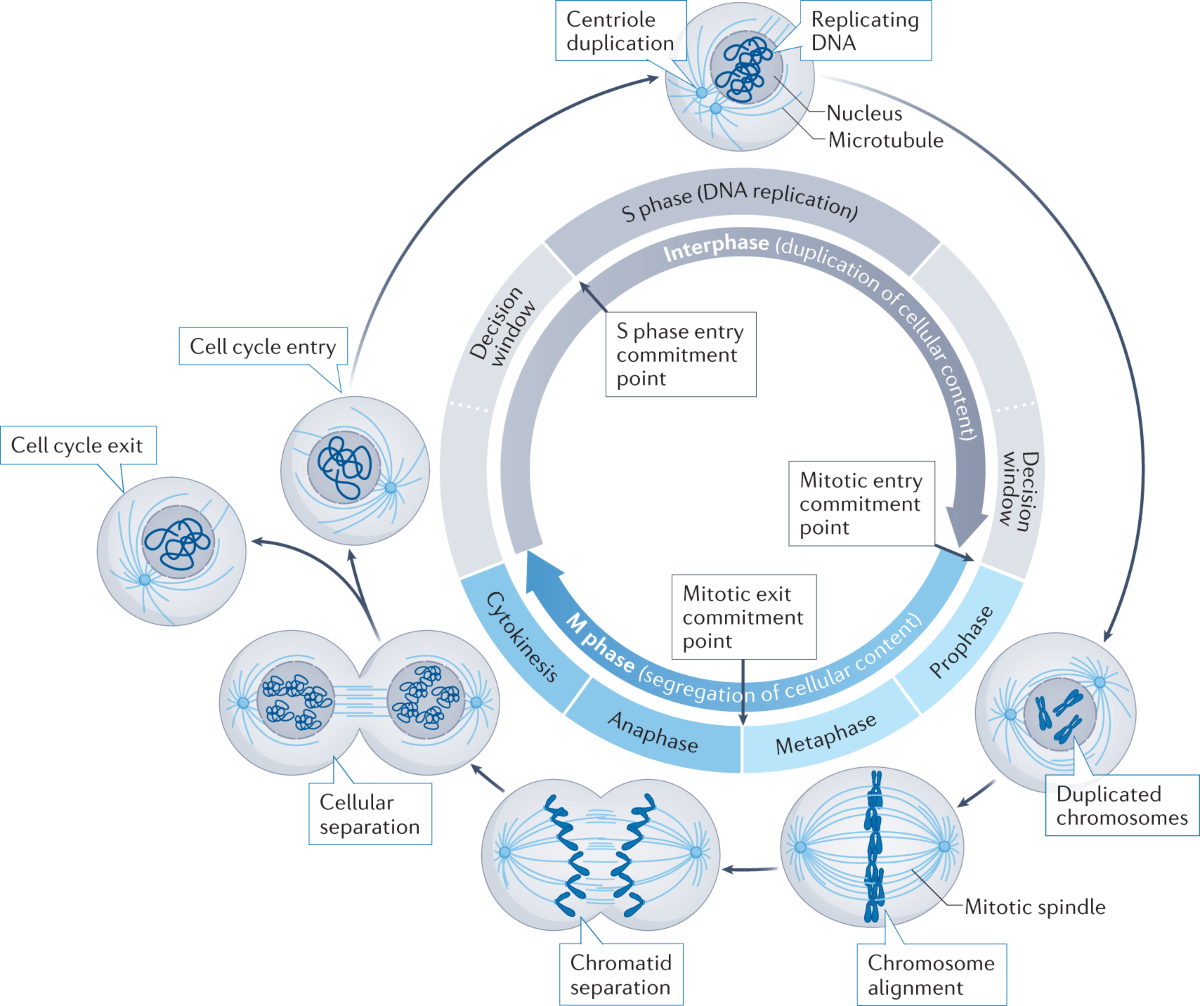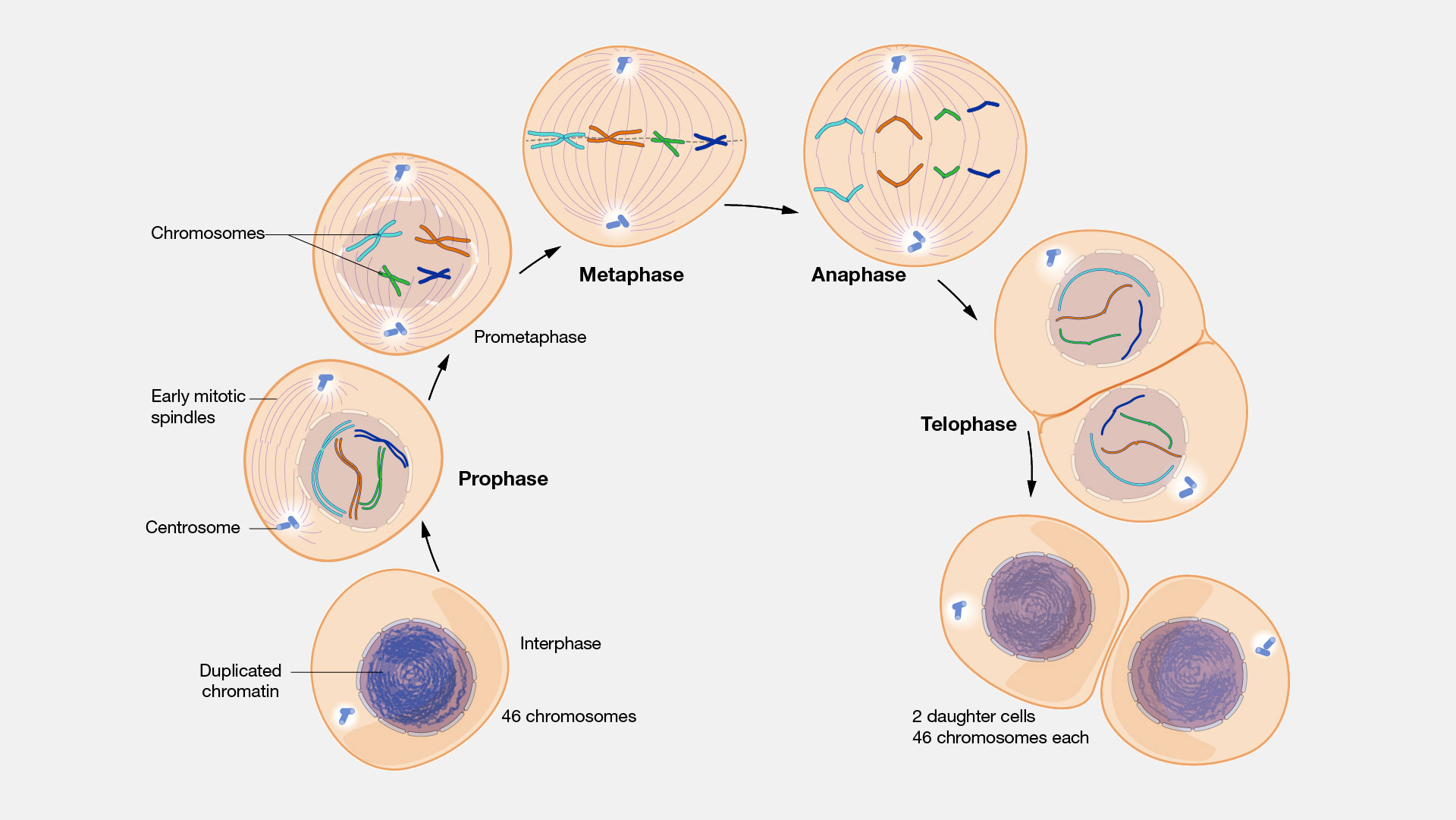
The Cell Cycle: An Essential Mechanism of Life
The cell cycle is a fundamental process that underpins growth, development, and maintenance in all living organisms. It is the series of stages through which a cell passes to divide and produce two daughter cells. Understanding the cell cycle is crucial for insights into development, cancer, and various cellular functions.

Overview of the Cell Cycle
The cell cycle is divided into two major phases:
- Interphase: The period of growth and DNA replication.
- M Phase (Mitotic Phase): The period of cell division.
Interphase
Interphase is the longest phase of the cell cycle, during which the cell grows, performs its normal functions, and duplicates its DNA. Interphase is subdivided into three phases:
-
The G1 phase (Gap 1) is the first stage of interphase in the cell cycle, following mitosis. During G1, cells grow in size, produce RNA, and synthesize proteins necessary for DNA replication. It also involves the monitoring of the environment and internal conditions to ensure cells are ready for DNA synthesis, acting as a critical checkpoint for cell cycle progression.
-
S Phase (Synthesis) is a phase of the cell cycle where DNA replication occurs. It begins with the unwinding of DNA strands by helicase enzymes. DNA polymerase then synthesizes new complementary strands using existing strands as templates. This ensures that each daughter cell receives a complete set of genetic information during cell division, essential for cellular growth and function.
-
G2 Phase is the third phase of interphase in the cell cycle, following DNA replication in S Phase and preceding mitosis or meiosis. It involves further growth and preparation for cell division. During G2, cells continue to grow and synthesize proteins necessary for mitosis. It also serves as a checkpoint to ensure DNA integrity before entering mitosis or meiosis.
M Phase (Mitotic Phase)
The M phase is the period of actual cell division, consisting of two processes: mitosis and cytokinesis.

Mitosis
Mitosis is the division of the nucleus and is further subdivided into five stages:
Prophase: Chromatin condenses into visible chromosomes, each consisting of sister chromatids. The nuclear envelope begins to disintegrate, and the mitotic spindle starts to form from centrosomes, which move to opposite poles, preparing for chromosome segregation.
Metaphase: Chromosomes align at the cell's equatorial plane, known as the metaphase plate. Spindle fibers attach to the centromeres of each chromosome, ensuring accurate segregation. This alignment is crucial for equal distribution of genetic material to daughter cells.
Anaphase: Sister chromatids are pulled apart by spindle fibers attached to their centromeres, moving toward opposite poles of the cell. This separation ensures that each daughter cell will receive an identical set of chromosomes.
Telophase: Telophase is the final stage of mitosis, where separated chromosomes arrive at opposite poles. Nuclear membranes re-form around each set of chromosomes, which begin to de-condense. The spindle fibers disintegrate, and the cell prepares for cytokinesis, dividing the cytoplasm to form two distinct daughter cells.
Cytokinesis
Cytokinesis is the final step in cell division, where the cytoplasm divides, creating two distinct daughter cells. In animal cells, this process involves the formation of a cleavage furrow, while in plant cells, a cell plate forms to separate the daughter cells.It occurs differently in animal and plant cells:
- Animal Cells: A contractile ring composed of actin and myosin filaments forms around the center of the cell, creating a cleavage furrow that pinches the cell into two.
- Plant Cells: A cell plate forms along the centerline of the cell, which eventually develops into a new cell wall, separating the two daughter cells.

Regulation of the Cell Cycle
The cell cycle is tightly regulated by a series of checkpoints that ensure the proper progression through each phase:
- G1 Checkpoint: Determines if the cell has adequate size, nutrients, and energy, and if the DNA is undamaged. If conditions are not favorable, the cell may enter a resting state called G0.
- G2 Checkpoint: Ensures that DNA replication in S phase has been completed correctly and that there is no DNA damage before entering mitosis.
- M Checkpoint (Spindle Checkpoint): Verifies that all chromosomes are properly attached to the spindle apparatus before Anaphase proceeds, ensuring correct chromosome separation.
Molecular Control of the Cell Cycle
The progression through the cell cycle is controlled by cyclins and cyclin-dependent kinases (CDKs). Cyclins are proteins whose levels fluctuate throughout the cell cycle, whereas CDKs are enzymes that, when activated by cyclins, phosphorylate target proteins to drive the cell cycle forward.
Clinical Relevance
Dysregulation of the cell cycle can lead to uncontrolled cell proliferation, a hallmark of cancer. Many cancer treatments aim to target specific phases of the cell cycle to halt the proliferation of cancer cells. For example:
- Chemotherapy: It is a cancer treatment that uses drugs to kill or slow the growth of cancer cells. It targets rapidly dividing cells, including cancer cells, but can also affect normal cells leading to side effects. Chemotherapy may be used alone or in combination with surgery, radiation, or other therapies to treat cancer.
- Radiation Therapy: Radiation therapy uses high-energy radiation to target and destroy cancer cells. It damages their DNA, inhibiting their ability to divide and grow. This treatment can be delivered externally (external beam radiation) or internally (brachytherapy), often alongside surgery or chemotherapy, to shrink tumors and eradicate cancerous cells.
Cell Cycle FAQ
The ECM, a complex network of proteins and carbohydrates surrounding cells, acts as a scaffold that provides structural support and regulates cell behavior. ECM components and mechanical cues from the microenvironment can signal to cells and influence cell cycle progression, differentiation, and migration through various signaling pathways and mechanotransduction mechanisms.
Metabolic pathways, such as glycolysis, oxidative phosphorylation, and amino acid metabolism, provide the energy and building blocks necessary for cell cycle progression. Metabolic enzymes and signaling pathways can directly influence cell cycle regulators, integrating cellular metabolic status with proliferation and growth control.
Non-coding RNAs, including microRNAs (miRNAs) and long non-coding RNAs (lncRNAs), have emerged as critical regulators of the cell cycle. They can modulate the expression of key cell cycle regulators, such as cyclins, CDKs, and tumor suppressors, thereby influencing cell cycle progression and cell fate decisions.
Dysregulation of the cell cycle is implicated in various diseases, particularly cancer. Targeted therapies aim to inhibit specific components of cell cycle regulation, such as CDK inhibitors for cancer treatment. Understanding cell cycle dynamics and vulnerabilities allows for the development of novel therapeutic approaches to disrupt cancer cell proliferation while sparing normal cells.
Nutrient availability and stress signals activate signaling pathways (e.g., mTOR and AMPK pathways) that regulate cell growth and division. These pathways integrate environmental cues to modulate cell cycle progression, ensuring cells only divide under favorable conditions and coordinating responses to stressors to maintain cellular homeostasis.
Tumor suppressor genes, like p53, monitor DNA damage and cell stress, activating repair mechanisms or triggering apoptosis if damage is severe. Oncogenes, such as cyclin D and CDKs, promote cell cycle progression. Mutations in these genes can lead to uncontrolled cell division, contributing to tumor formation and cancer progression.
Conclusion
The cell cycle is a meticulously regulated process that is essential for life. It ensures that cells grow, duplicate their DNA accurately, and divide properly. Understanding the cell cycle's mechanisms and regulatory checkpoints provides critical insights into cellular function and the development of diseases like cancer, offering pathways for therapeutic interventions.
Check out this article on Khanacademy https://www.khanacademy.org/science/ap-biology/cell-communication-and-cell-cycle/cell-cycle/a/cell-cycle-phases





